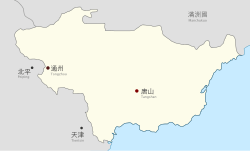East Hebei Autonomous Council
| East Hopeh Autonomous Council | ||||||||||
| 冀東防共自治政府 Jìdōng Fánggòng Zìzhì Zhèngfǔ Kitō Bōkyō Jichi Seifu | ||||||||||
| Puppet state of the Empire of Japan | ||||||||||
| ||||||||||
|
| ||||||||||
 Map of East Hebei Autonomous Council | ||||||||||
| Capital | T'ungchow (now Tongzhou, Beijing) | |||||||||
| Languages | Mandarin | |||||||||
| Government | Republic | |||||||||
| Chairman | Yin Ju-keng | |||||||||
| Historical era | Second Sino-Japanese War | |||||||||
| • | Established | 25 November 1935 | ||||||||
| • | Disestablished | 1 February 1938 | ||||||||
| Area | ||||||||||
| • | 1937 | 8,200 km² (3,166 sq mi) | ||||||||
| Population | ||||||||||
| • | 1937 est. | 6,000,000 | ||||||||
| Density | 731.7 /km² (1,895.1 /sq mi) | |||||||||
| Currency | Chi Tung Bank-issued yuan, on par with Japanese yen and Manchukuo yen | |||||||||
| ||||||||||
The East Hopeh Autonomous Council (Chinese: 冀東防共自治政府; pinyin: Jìdōng Fánggòng Zìzhì Zhèngfǔ),[1] also known as the East Ji Autonomous Council and the East Hopei Autonomous Anti-Communist Council, was a short-lived late-1930s state in northern China. It has been described by historians as either a Japanese puppet state or a buffer state.
History
After the creation of Manchukuo and subsequent military action by the Imperial Japanese Army, which brought Northeastern China east of the Great Wall under Japanese control, the Empire of Japan and the Republic of China signed the Tanggu Truce, which established a demilitarised zone south of the Great Wall, extending from Tientsin to Peiping (Peking). Under the terms of the truce and the subsequent He-Umezu Agreement of 1935, this demilitarized zone was also purged of the political and military influence of the Kuomingtang government of China.
On 15 November 1935 the local Chinese administrator of the 22 counties in Hopei province, Yin Ju-keng, proclaimed the territories under his control to be autonomous. Ten days later, on 25 November, he proclaimed them to be independent of the Republic of China and to have their capital at T'ungchow. The new government immediately signed economic and military treaties with Japan. The Demilitarized Zone Peace Preservation Corps that had been created by the Tanggu Truce was disbanded and reorganized as the East Hopei Army with Japanese military support. The Japanese goal was to establish a buffer zone between Manchukuo and China, but the pro-Japanese collaborationist regime was seen as an affront by the Chinese government and a violation of the Tanggu Truce.
The East Hebei Autonomous government received a response in the form of Gen. Song Zheyuan's Hebei-Chahar Political Council, which was under the Nanjing government, launched on 18 December 1935.[2][3] Chinese soldiers remained in the area.[4]
The East Hopeh government survived the Tungchow Mutiny in late July 1937 before being absorbed into the collaborationist Provisional Government of China in December 1937.
See also
Notes and references
- ↑ Japanese Kitō Bōkyō Jichi Seifu (冀東防共自治政府)
- ↑ Shizhang Hu (1 January 1995). Stanley K. Hornbeck and the Open Door Policy, 1919-1937. Greenwood Publishing Group. pp. 213–. ISBN 978-0-313-29394-8.
- ↑ Michael A. Barnhart (14 February 2013). Japan Prepares for Total War: The Search for Economic Security, 1919–1941. Cornell University Press. pp. 42–. ISBN 0-8014-6845-0.
- ↑ Great Britain. Foreign Office (1984). Documents on British Foreign Policy, 1919-1939. H.M. Stationery Office. p. 16.
Further reading
Coordinates: 39°48′N 116°48′E / 39.800°N 116.800°E
.svg.png)